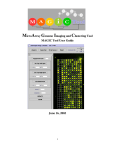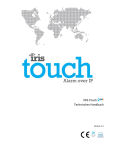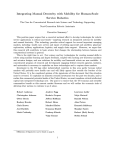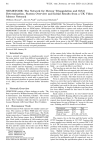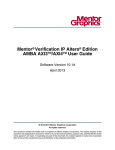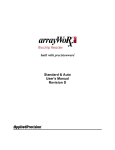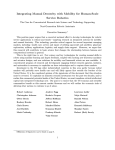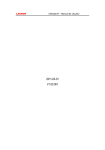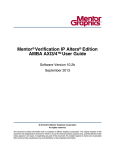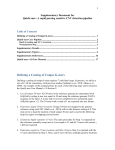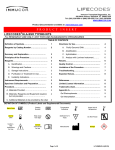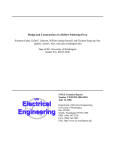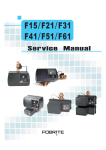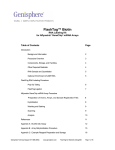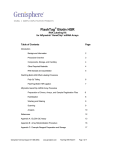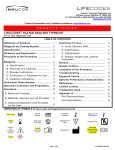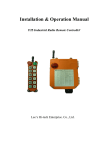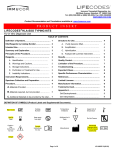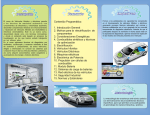Download DNA microarrays: How to Make Your Own “Teaching Chips” Spring
Transcript
DNA microarrays: How to Make Your Own “Teaching Chips” Spring, 2005. Davidson College. Amore, A., Bossie, S., Citrin, M., Cobain, E., McDonald, M., Solé, M., Wilson, E., Choi, D., Oldham, E., Pierce, D. and Campbell, A.M. ABSTRACT DNA microarrays are an important tool in the fast-growing field of genomics. The purpose of this investigation was two-fold. First, we learned to design and print DNA microarrays, identifying some of the areas in these processes which we found problematic. Despite our results, it is likely that results using the method described here will improve. Our second goal was to develop a “teaching chip” protocol to be used in other undergraduate settings. This paper describes one way that microarrays could be incorporated into undergraduate genomics courses. INTRODUCTION DNA microarrays are becoming increasingly prevalent because this technology provides investigators the opportunity to explore simultaneously the interactions among all genes in an organism’s genome. Integrating comprehensive genomic research opportunities into undergraduate education will facilitate advancement of the field of genomics, thus broadening the potential medical applications of microarray technology. The pedagogical value of this type of investigation is tremendous. Students gain experience designing and implementing original experiments in addition to improving their understanding of the principles underlying the creation and analysis of microarrays. As students become confident with their abilities to explore microarray technology, they will develop a comprehension that will rapidly escalate the utility of similar methodologies. For example, pharmacogenomics examines how a patient’s genetic makeup affects his or her response to a therapeutic drug regimen; an explosion of interest in this field would positively affect an incredible number of patients. A basic introduction to microarrays is available at the following web address: http://www.ncbi.nlm.nih.gov/About/primer/microarrays.html (Microarrays, 2004). Further conceptual information, including a description of the history and potential of “The Microarray Revolution,” is presented in an article from Biochemistry and Molecular Biology Education by Brewster (2004). Complementary DNA base pairing permits the target/probe hybridization, which is the foundation of microarray technology. The essential steps to this process are as follows: grow cells, isolate and extract RNA, convert mRNA into cDNA, hybridize with Cy3 and Cy5 tagged probes, scan chip to measure fluorescence intensity, analyze data to determine repression and induction patterns from image profiles. For an animated overview of DNA microarray methodology, please refer to the following website: http://www.bio.davidson.edu/Courses/genomics/chip/chip.html (Campbell 2001). The utility of teaching chips stems from the fact that no RNA or genomic DNA is required for the methods presented in this paper. Rather than traditional RNA hybridization, the probes we used are oligonucleotides that are detected with Genisphere's 3DNA kit (Figure 1). This method is advantageous because students have the opportunity to learn through the active creation and analysis of microarrays while the cost of reagents is minimized. Cy5 dendrimer Cy3 dendrimer 5’ 31mer capture sequence 5’ 30mer oligo probe 500mer target 3’ 31mer capture sequence 30mer oligo probe 3’ 500mer target Figure 1: A schematic of the 3DNA labeling method. 61mer oligonucleotide probes are hybridized to the microarray. 30 of these 61 base pairs bind to the 500mer target, and 31 bind to the dendrimer. Dendrimers fluoresce either red (Cy5) or green (Cy3). Methods: Sample Preparation: In this study, we used three S. cerevisiae genes (idh1, mhp2 and SHY) previously cloned into bacterial plasmids and 61bp probes with complementary sequences to these genes which contained a 5’ capture sequence, the Cy5 (red) and Cy3 (green) dyes (D. Pierce and A.M. Campbell, unpublished). In the previous study, 500bp fragments of these yeast genes, which had no sequence similarity, were PCR amplified. These PCR products were then cloned into plasmid pCR 2.1-TOPO. Competent bacterial cells (JM109) containing these plasmids were grown in 50mL LB Broth containing 50µl Ampicillin at 37°C for 16 hours. Plasmids were isolated using both the Qiagen HiSpeed Plasmid Purification Kit and the less expensive Promega Pure Yield Plasmid Midi Prep System. Plasmid isolation from both kits was confirmed by detection of DNA on a 0.7% agarose gel. Isolated DNA from both kits was quantified by spectrophotometry and the yields were compared. We then performed an ethanol precipitation of the DNA that was isolated. Designing a “Teaching Chip”: Our aim in this design was to orient the plasmid DNA from the three yeast genes previously prepared onto the chip in a simple pattern that would yield clear results. We decided that we would spot the plasmid DNA for these three genes in a “stoplight” pattern, which, after hybridization with both red and green probes for these gene sequences and merging of red and green images using MagicTool software would yield a red circle (mhp), a yellow circle (idh1) and a green circle (SHY) (Figure 2). We decided that in the space surrounding the genes printed on the chip we would print a buffer solution. Figure 2: Stoplight design using mhp (red), idh1 (yellow) and SHY (green) genes as targets. Buffer solution was printed in all black squares that do not contain a gene name. Printing the “Teaching Chip”: DNA chips were printed on CSA amino slides (CEL Associates) in the pattern described above using the BioRobotics MicroGrid II Compact. A total of 20_l of the DNA for each gene was pipetted into the microwell plate in a 1:1 ratio with spotting solution before printing. See Appendix A for printing instructions. Post-Printing Processing: After printing, slides were crosslinked by UV light for three minutes using a DNA transfer lamp from Fotodyne. Pre–Hybridization Wash: See appendix B Hybridization Procedure: See appendix C Scanning Analysis: Slides were scanned using an arrayWoRx escanner from Applied Precision. Results and Discussion: Sample Preparation: We isolated plasmid DNA using both the Qiagen HiSpeed Midi Prep Kit and the Promega Pure Yield Plasmid Midi Prep System. We ran all samples on a 0.7% agarose gel to confirm that DNA had been recovered. The results from the gel indicated that both kits did recover plasmid DNA in approximately equal amounts (Figure 3). In order to compare the DNA yields achieved by both kits, we conducted a spectrophotometric analysis to determine the concentration of DNA in each sample (Table 1). Both kits produced similar DNA yields, indicating that they are equally as efficient despite the difference in price of the two products. We did find that one Promega sample (idh1 #3) had an unusually high yield however, we believed this to be due to the high protein content in the sample (Table 1). Although both kits were able to produce comparable yields, we found the Qiagen kit to be most user friendly. Although the Qiagen kit is more expensive, there were very few materials necessary to complete the plasmid isolation outside of what was provided in the kit, whereas the Promega kit required several centrifugation steps that were often cumbersome. After ethanol precipitation of these samples, we chose the one sample of each gene with an OD260/280 ratio closest to 1.8 and a high concentration of DNA when compared to the other samples of the same gene to use for printing our chips (Table 2). Figure 3: Confirmation of DNA isolation from bacterial cells containing plasmids with SHY, mhp and idh1 inserts. Lane 1 = idh1#1, Lane #2 = idh1#2, Lane 3 = idh1#3, Lane 4 = mhp#2, Lane 5 = mhp #3, Lane 6 SHY#1 and Lane 7 = SHY#2. Equal volumes of each sample were loaded into each lane. Table 1: Concentration of each sample isolated with either Qiagen or Promega kits as determined by spectrophotometric analysis. Sample OD 260/280 Concentration Kit (µg/ml) Name idh1 #1 1.76 370 Qiagen idh1 #2 1.76 440 Qiagen idh1 #3 1.32 790 Promega mhp #1 1.02 420 Qiagen mhp #2 1.375 330 Qiagen mhp #3 1.82 200 Promega SHY #1 1.81 290 Qiagen SHY #2 1.83 220 Promega SHY #3 1.71 290 Qiagen Table 2: OD260/280 ratio and concentration of each sample after ethanol precipitation. Samples highlighted in blue were those chosen to use in the printing process. Idh1 1a Idh1 1b Idh1 2a Idh1 2b Idh1 3a Idh1 3b OD260 0.360 0.046 0.015 0.266 0.353 0.512 OD280 0.220 0.046 0.017 0.164 0.247 0.375 260/280 1.64 1.00 0.88 1.64 1.43 1.37 Concentration (ug/mL) 7.20 0.92 0.30 5.32 7.06 10.24 Mhp 1a Mhp 1b Mhp 2a Mhp 2b Mhp 3a Mhp 3b 0.183 0.528 0.305 N/A 0.399 N/A 0.105 0.303 0.171 N/A 0.285 N/A 1.74 1.74 1.78 N/A 1.40 N/A 3.66 10.56 6.10 N/A 7.98 N/A SHY 1a SHY 1b SHY 2a SHY 2b SHY 3a SHY 3b 0.356 0.340 0.200 N/A 0.327 0.282 0.208 0.194 0.135 N/A 0.243 0.177 1.71 1.75 1.48 N/A 1.35 1.59 7.12 6.80 4.00 N/A 6.54 5.64 Printing and Analysis: After attempting the printing protocol several times, we were unable to produce a visible stoplight pattern on any of our slides. Initially, there were several factors that we believed contributed to this outcome. First, we recognized during the printing procedure that our robot was not properly calibrated. However, after recalibration of the robot we still encountered several difficulties. We also recognized that a probable source of error included our failure to combine spotting solution in a 1:1 ratio with DNA sample in the microwells before printing. Many of our initial scans revealed that our spots had dried up, leaving very little sample on the slide for the probe to detect (data not shown). Once this error was recognized, spotting solution was used in all subsequent trials. After correcting these errors, we were still unable to obtain positive results (i.e. no fluorescence was detected by the scanner). In order to further investigate probable sources of error, we constructed a test slide that was hand spotted using 0.5_l of each plasmid sample (120ng/_l and 240ng/_l), each oligo (provided by Sigma Proligo) and two positive controls (provided by Genisphere) (Figure 4A). Once again, we were unable to detect fluorescence on any spots other than the positive controls (Figure 4B). A B Figure 4: Test Slide Design and Results. A: Anticipated results if all reagents were functioning properly. O = oligo, RT = Reverse Transcript, C = control. B: Only the two positive controls fluoresced as expected Based upon these results we suspected that the capture sequence on the oligos used were not complementary to the dendrimer sequences, thus not allowing binding to occur. We determined that these sequences were in fact not complementary and thus, ordered new oligos with the correct capture sequence (Table 3). Table 3: Correct capture sequences for Cy3 and Cy5 dendrimers Cy3 5’ TTC TCG TGT TCC GTT TGT ACT CTA AGG TGG A 3’ Cy5 5’ ATT GCC TTG TAA GCG ATG TGA TTC TAT TGG A 3’ Once the oligos with the correct capture sequence were obtained, we were able to obtain positive results (Figure 5). Despite the many other sources of error discussed previously, this mistake was by far the most significant. As a next step, the results obtained should be analyzed using MagicTool® in order to quantify the level of fluorescence. Also, optimization of the Cy5:Cy3 ratios needed to increase the fluorescence of Cy5 should be completed, as our Cy5 signal was a bit weak. Figure 5: Results obtained using oligos with the correct capture sequence (Table 3). Note the appearance of the stoplight pattern. We believe this protocol will be a useful teaching tool in the undergraduate laboratory setting for students who have been introduced to these techniques previously in the classroom. This protocol gives undergraduate students the freedom to design their own custom “teaching chips” and bridges the knowledge gap between understanding the methodology and the actual practice of the technique. With this basis, it is likely that undergraduate students will be able to undertake more complex DNA microarray experiments which may otherwise only be considered feasible in a graduate setting. Appendix A: Modified Protocol for Cleaning the Pins 1. Soak pins in 50mM KOH for 5 minutes, careful not to let pin holder touch the liquid (aluminum will get corroded). 2. Rinse pins in dH2O by wiggling in cup for ~5 seconds twice (in 2 separate containers) to wash away excess salt. 3. Sonicate for 30 minutes to 1 hour with enough distilled water to fill basin within an inch of the rim. 4. Soak in 90-95% EtOH for 30 minutes to 1 hour. 5. Let pins dry by hanging above EtOH for at least 5 minutes and not too much longer (dust). 10 minutes + 1 hour + 1 hour +10 minutes = 2 hours and 20 minutes Notes: •Never let pin tips touch bottom of any container. •It’s important to let pins dry before running the printer: washes may not be sufficient to get EtOH off. •30 minutes may be sufficient as a minimum for sonicate/soak, but the longer they do each, the better they perform. •Always wear powder-free gloves when handling the pin tool. •Always clean pins before a major run. Once the pin tool has been placed back in its polyethylene holder, it must be cleaned carefully in order to work. Robot information: Username: chippers Password: spotters ArrayWoRx information: Username: awuser Password: serca2a Designing the printing pattern Before you begin, you must decide on a printing pattern that establishes the orientation of the spots on your chip. We designed a pattern that mimicked a stoplight using three Mhp Mhp Mhp Mhp Mhp Mhp Mhp Mhp Mhp Mhp Mhp Mhp Mhp Mhp Mhp different genes (idh1, mhp, and SHY). Asymmetric designs are best so you can orient your slide after scanning. Mhp Mhp Mhp Mhp Mhp Mhp Mhp Mhp Mhp Mhp Mhp Mhp Mhp Mhp It was helpful to use the cells of an Excel spreadsheet to plan the Mhp Mhp Mhp Mhp Mhp Mhp Mhp Mhp idh1 idh1 idh1 idh1 idh1 idh1 idh1 idh1 idh1 idh1 idh1 idh1 idh1 idh1 idh1 idh1 idh1 idh1 idh1 idh1 idh1 idh1 idh1 idh1 idh1 idh1 idh1 idh1 idh1 idh1 idh1 idh1 idh1 idh1 spotting pattern. On your first attempt, it is best to choose a simple design to establish a basic level of understanding. The key to a simple design is a clear pattern while limiting the number of genes used. Be sure when you choose your genes and probes, you are idh1 idh1 idh1 aware of any partner-probe interactions, i.e. one probe with the SHY SHY SHY SHY SHY SHY SHY SHY capacity to bind multiple genes (See D. Pierce, 2003). SHY SHY SHY SHY SHY SHY SHY SHY SHY SHY SHY SHY SHY SHY SHY SHY SHY SHY SHY SHY SHY SHY SHY SHY SHY SHY SHY SHY SHY Figure 1. Above is the design for our stoplight. The red, yellow and green colors were generated using the appropriate ratios of Cy3:Cy5. Preparing the Robot When not in use, be sure to keep the lid of the robot closed. It is best if the machine is not in direct sunlight: be sure the blinds are closed, as this can alter humidity and temperature beyond the control of the robot. First, the main power unit should be filled with 6 Liters of de-ionized water. The bottle in the humidification control unit also needs to be filled with de-ionized water to use the climate control system. The white trays known as wash baths 1 & 2 should be filled with de-ionized water for washing the pins. There are two slide trays in the robot. Be sure all holes on the slide tray(s) you are using are covered, as this is necessary for creating a vacuum that will hold the slides in place. If you are not using all slide slots in your study, you can cover the extra holes on the tray by placing spare slides horizontally (see Fig. 2 on page 5). Sample Preparation Once a design has been decided upon, you must consider how the DNA samples will be placed in the robot. The machine can hold samples in either a 96-well plate or a 384-well plate. Although slides in most experiments will not require 384 separate samples, the use of a 384-well plate is highly recommended. This is due to the fact that the smaller surface area of the wells in the 384-well plate decreases volume of DNA needed and the amount of evaporation. Next it will be necessary to determine how many samples you will need to print your slide. In our design, we filled 3 wells with sample DNA plus spotting solution in a 1:1 ratio and 3 wells with buffer solution (1X TE). Each well in use should contain 10 to 25µl of sample; in our investigation, we used 20µl of sample per well. Software To begin your journey into microarray printing, first turn on your robot by switching on the main power unit (MPU), followed by the humidification control unit (HCU). Figure 2. The robot and its components: Main Power Unit (MPU), Humidification Control Unit (HCU). It is now time to explore the wonderful world of your TAS Application Suite. Once the program is opened, click on ‘New Microarray’ under the ‘File’ menu. The screen should appear like this: Options: Under the options tab, you will define your well plate size (under ‘group’) and the pin configuration (under ‘tool’). ‘Spots per source visit’ represents the number of times each pin will touch the slides before returning to the 384-well plate (called the source). This number should not exceed 30 to ensure the pin does not run out of sample. Under ‘wash frequency’ you should choose ‘wash before new source visit,’ which ensures that no sample mixing of DNA occurs. Next, click on the ‘Source’ tab. Source: Under the ‘Source’ tab, you will define where and how the pins will print. Under ‘Microplate Group’ choose ‘Classic Plate Definitions’. Be sure that under ‘Microplate Type’ your specific well plate is selected. ‘Number of Plates’ is the number of source plates. This option should be set at one since the MicroGridII Compact only has the capacity to hold one microwell plate. The ‘Number of Samples’ is dependent upon the printing pattern and pin configuration you have chosen. In our study, we wanted to print from six wells in the following configuration: Figure 3. Sample placement in the 384-well plate. We printed from this sample configuration using 3 pins. A 3x1 pin configuration is not a program option; therefore, we utilized the 3x2 pin configuration without loading the second column of pins into the tool. Figure 4. Robot arm and pin arrangement. When a 3x2 pin configuration is chosen, the software assumes that 6 samples are present in the source in a corresponding 3x2 configuration, filling wells A1-A3 and B1-B3. When the ‘Number of samples’ tab is changed to 12, the software assumes that DNA samples occupy wells A1-A3, B1-B3, C1-C3, and D1-D3. The software is then able to obtain sample from wells A1-A3 and B1-B3 in one source visit, and sample from wells C1-C3 and D1-D3 in a second source visit. In order to print our design, we set the sample number at 12, loading our samples into wells A1-A3 and C1-C3. With this setup, we were able to utilize a 3x2 pin configuration with only 3 pins and 6 true samples. ‘Last plate’ defines how many different wells each pin will visit. For example, a 6-pin setup making two visits to the microwell plate will require a total of 12 sample wells. Pay attention to the text in this box; green means excellent (source visits and available tool spots match), black is acceptable (source visits are less than the available tool spots), and red indicates that a run cannot be initiated (source visits are greater than the available tool spots). Under ‘Source loading into adapter plates’ you must choose how many well plates the robot will hold at a time. Once again, this robot holds only 1 well plate. On the right side, you will see an overall picture of the slide positions. If slides appear red the problem must be addressed under the ‘Target’ tab. Under ‘Source action’ choose the ‘Dip’ option when using split pins (which is what we use). ‘Prompt for plates’ is not available in the MicrogridII Compact. Next, open the ‘Target’ tab. Target: Options under the ‘Target’ tab are very project specific. We will guide you on our journey and try to explain the general logic (or lack thereof) of the software. Under the ‘Tool array definition’ you must click on the ‘Edit pattern’ button to inform the software of the design you previously created (e.g. the spotlight). First enter the values for the size of the grid that each pin will print. Each numbered square represents one spot on the slide. The numbers in the boxes correspond to the positions of the samples in the 384-microwell plate. When you click on the yellow spots in the black box that appears at the top of the screen, the well plate coordinates are displayed as seen below: Under ‘Format’ click ‘Custom,’ as this allows you to create your own unique microarray pattern. Choose n = x (entering your desired number, i.e. n = 2 for duplicates) if you wish to print replicates of each sample on your slide. Click ‘OK’ to return to the main ‘Target’ window. Next under ‘Adapter Plate and Slide Layout,’ you will define the number of targets (slides) to be printed. Click on ‘Edit Layout’ button. Then, under ‘Adapter Layout’ you must select 27 vertical slides from the pull down menu. See image below: 384-Microwell Plate Click on the ‘Slide Layout’ tab to define the margins of your slide. Each margin can be changed independently and ultimately the design should be near the center of the slide. Each colored area (numbered 1, 2, 3, etc.; yellow 1 in our case) represents a full printing of your design, NOT the printing of each individual pin. Here you can determine how many times you would like your design to be printed on each slide. In our investigation, we printed our design one time on each slide. To adjust pattern replication, expand or contract the margins. If red appears under the ‘Source’ tab, the problem is likely due to your margin settings. Click ‘OK’ to return to the main ‘Target’ window. Under ‘Target Action,’ the settings which appear in the image above are ideal for the robot. Pre-spotting removes excess liquid from the tip of the pin and ensures all subsequent spots are of equal size. If you choose to pre-spot, which is highly recommended, click on the ‘Edit pre-spot’ button. The ‘Number of pre-spots’ should be 1, confining the pre-spotting to a single slide. Under ‘Historical Options’, designate the number of ‘Multiple strikes’ to be 5. In our study, we accepted the default settings under ‘Pre-spotting protocol’, but for specific descriptions of other pre-spotting options consult the user manual. Click ‘OK’ to return to the target window. A left mouse button click on the ‘Edit soft touch’ button, transports you to a whole new world of decision making. This option slows the speed of the pins before they make contact with the slide. The default settings worked well and resulted proper spot morphology. In this window, Under the ‘Climate’ tab, you can control the humidity settings. Below are the settings we chose. In the graph box, the yellow line represents the actual humidity inside the robot, the red line represents the minimum acceptable humidity, and the green line represents the target humidity that is to be maintained throughout the run. If the machine humidity is not set correctly, the spots will not dry uniformly. Next, under the ‘Baths 1&2’ tab, select both baths for washing. Set ‘Wiggle’ in the ‘Action’ box to no greater than 0.200mm. Be sure that ‘Use recirculating baths as static baths’ is selected. We left all other tabs at default settings. Click ‘OK.’ You are now ready to roll! Click the green ‘GO’ button that appears in the tool bar at the top of the screen. The program will then prompt you to load the tool. After loading the tool, close the lid and click ok. Next, you will be prompted to ‘clean and load tray 1, and click OK to switch on the vacuum.’ Be sure to push slides to the bottom (closest to you) left corner of each slide slot. Figure 5. Tray 1 setup with slides covering holes that create the vacuum. After the vacuum is activated, the program will prompt you to ‘check that the slides are held well. Check this by trying to move a slide and click ‘OK.’ The robot will begin its run automatically. Sit back and relax until the run is finished. Do not click the ‘Stop’ button unless you wish to terminate your run. The ‘Pause’ button allows you to halt the program temporarily so that you can make minor adjustments to the program before continuing your journey. Appendix B: Pre-hybridization Wash 1. Wash the slides in 0.1% SDS for 2 min. (at RT) 2. Repeat step 1 3. Wash the slides in dH2O for 2 min. (at RT) 4. Boil the slides in H2O for 2.5 min. 5. Place the slides in 95% ethanol for 1 min. (at RT) 6. Spin at 1600 rpm for 2 min (or spray with pressurized CO2) Appendix C: 1. Resuspend the oligos to a final concentration of 1ng/µl. 2. Vortex 25 µL of Buffer #6 (Genisphere®), 4 µL of each oligo, 1 µL calf thymus DNA (1 ng/µL) and heat at 80°C for 10 min. This is the hybridization mixture. Table 1: Oligonucleotide Probes With Corrected Capture Sequence (Not Bolded) Cy3 SHY 5’ TTC TCG TGT TCC GTT TGT ACT CTA AGG TGG A GCTGTAAACGGAACGCAAGCTGTTGATAAT 3’ Cy3 idh1 5’ TTC TCG TGT TCC GTT TGT ACT CTA AGG TGG A GAACATGAATCCGTCCCTGGTGTAGTGGAA 3’ Cy3 Mhp 5’ TTC TCG TGT TCC GTT TGT ACT CTA AGG TGG A AGTGATACCAACGGTACGAACGCAGATGAT 3’ Cy5 SHY 5’ ATT GCC TTG TAA GCG ATG TGA TTC TAT TGG A GCTGTAAACGGAACGCAAGCTGTTGATAAT 3’ Cy5 idh1 5’ ATT GCC TTG TAA GCG ATG TGA TTC TAT TGG A GAACATGAATCCGTCCCTGGTGTAGTGGAA 3’ Cy5 Mhp 5’ ATT GCC TTG TAA GCG ATG TGA TTC TAT TGG A AGTGATACCAACGGTACGAACGCAGATGAT 3’ Table 2: Oligo ratios used. Concentration (ng/_l) Cy3 SHY 2620 Cy3 idh1 2380 Cy3 Mhp 1730 Cy5 SHY 2030 Cy5 idh1 3050 Cy5 Mhp 3150 3. In a test tube mix together the volume of hybridization mixture needed of each probe in the appropriate ratios. See above (Table 3) for an example for our stoplight design. 4. Pipet 10µl of mixture onto slides under glass coverslip and incubate prepared slides at 42°C overnight, 12-18 hours 5. Wash slides in a Coplin jar with 2X SSC/ 0.2% SDS for 15 min. at 37°C 6. 2X SSC for 10 min. at room temperature 7. 0.2X SSC for 10 min. at room temperature 8. 95% EtOH for 1 min without air drying 9. Spin at 1600 rpm for 2 min. 10. Vortex 2.5 µL Cy3 dendrimer, 2.5 µL Cy5 dendrimer (or dH2O if only one fluorophore is used) and 45 µL buffer #6; heat at 80°C for 10 min. 11. Incubate hybridized slides at 54°C for 2 hours 12. Using Coplin jars wrapped in aluminum foil, wash slides in 2X SSC/ 0.2% SDS for 15 min. at 54°C 13. 2X SSC for 10 min. at room temperature 14. 0.2X SSC for 10 min. at room temperature 15. 95% EtOH for 1 min without air drying 16. Spin at 1600 rpm for 2 min (or spray with pressurized CO2) 17. Keep slides in dark until ready to scan.
























